Table of Contents
History of Rock-Roll
Rock and Roll traces its roots back to the sounds of the West African Griot. Carried by those shackled in slavery Rock and Roll would emerge from the fields, homes, and churches of the African Diaspora.
The key instrument,the guitar, has Portuguese roots, but the Banjo variety that proceeded the rock-in roll sound descends from a West African variant. The guitar, popularized among the Black community through the Sears Catalog, combined with first West African and later Latin beats lead to the emergence of the Blues from Gospel and Country. Combine a bit of the Swing happening out on the West Coast, with singing on the East Coast and a genre was born from that which always was.
The Blues
Blind Lemon Jefferson
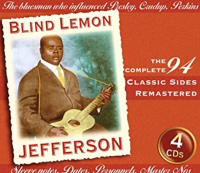 Jefferson's guitar sound and Muddy Waters stop-time rhythm would become the backbone of Rock-n-Roll. Jefferson is called the father of Texas Blues whose roots in Gospel and Country would become rock-roll. Jefferson grew up as a musician in the Deep Elm section of Dallas and then moved to Chicago as the Blues scene took off. Long before Biggee and Tupac Blind Lemon's death remains a mystery but many believe it to be a beef over royalties.
Jefferson's guitar sound and Muddy Waters stop-time rhythm would become the backbone of Rock-n-Roll. Jefferson is called the father of Texas Blues whose roots in Gospel and Country would become rock-roll. Jefferson grew up as a musician in the Deep Elm section of Dallas and then moved to Chicago as the Blues scene took off. Long before Biggee and Tupac Blind Lemon's death remains a mystery but many believe it to be a beef over royalties.
Charlie Patton
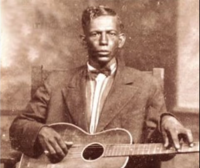 While Blind Lemon Jefferson fathered the Texas Blues sound Charlie Patton created the Delta Blues that brought the guitar into the picture. Before the Delata Blues musicians in the south used the same ensembles from the slave quarters. This included fiddles and banjos, accompanied by various percussion instruments, usually the tambourine and two bones being struck together as claves. Of the Banjo Thomas Jefferson said: “which they brought with them from the hinterlands of Africa.”
While Blind Lemon Jefferson fathered the Texas Blues sound Charlie Patton created the Delta Blues that brought the guitar into the picture. Before the Delata Blues musicians in the south used the same ensembles from the slave quarters. This included fiddles and banjos, accompanied by various percussion instruments, usually the tambourine and two bones being struck together as claves. Of the Banjo Thomas Jefferson said: “which they brought with them from the hinterlands of Africa.”
Charlie Patton moved to Dockery Farms as his father did not want him learning the secular music espoused by a former slave musician Henderson Chatmon. Instead Patton transformed Dockery Farms into the Delta Delta Blues hotbed with Tommy Johnson, Son House, Robert Johnson, and Howlin' Wolf playing,
When you played the steel guitar, the instrument of Delta Blues, with a slide it made similar sounds of the single-string didley-bow, a slave invented instrument adapted from it's Ghana roots.
Robert Johnson
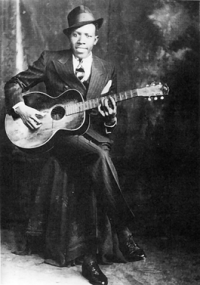 Robert Johnson spawned the Delta Blues in a recording career that lasted only 7 months but his traveling on the Dallas Blues circuit helped to cement the Delta Blues. Johnson invented the oogie bass pattern“ or “boogie shuffle” technique and is described as a “fifth–sixth [degrees of a major scale] oscillation above the root chord. This would become the foundation of Post War Blues.
Robert Johnson spawned the Delta Blues in a recording career that lasted only 7 months but his traveling on the Dallas Blues circuit helped to cement the Delta Blues. Johnson invented the oogie bass pattern“ or “boogie shuffle” technique and is described as a “fifth–sixth [degrees of a major scale] oscillation above the root chord. This would become the foundation of Post War Blues.
Muddy Waters
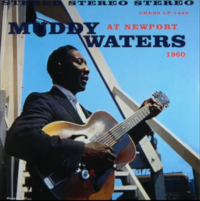 You can not overstate McKinley Morganfield, Muddy Water's, impact on music. Considered a founder of the Chicago Blues, which fused Texas and Delta Blues into a unique sound, he created the beginnings of Rock and Roll.Born in Mississippi sometime between 1913-1915 Waters cut his teeth in Church.
You can not overstate McKinley Morganfield, Muddy Water's, impact on music. Considered a founder of the Chicago Blues, which fused Texas and Delta Blues into a unique sound, he created the beginnings of Rock and Roll.Born in Mississippi sometime between 1913-1915 Waters cut his teeth in Church.
“I sold the last horse that we had. Made about fifteen dollars for him, gave my grandmother seven dollars and fifty cents, I kept seven-fifty and paid about two-fifty for that guitar. It was a Stella. The people ordered them from Sears-Roebuck in Chicago.”
T-Bone Walker
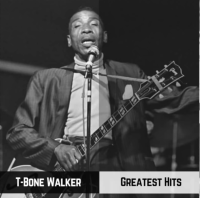 If Muddy Waters and Blind Lemon Jefferson helped shape the Rhythm of Rock-n-Roll. T-Bones Walker 12 String Blues Guitar laid the foundation for the electric sound. Aaron Thibeaux Walker was born in Linden, Texas of African and Cherokee descent. Growing up in a musical family Blind Lemon Jefferson would be over for dinner.
If Muddy Waters and Blind Lemon Jefferson helped shape the Rhythm of Rock-n-Roll. T-Bones Walker 12 String Blues Guitar laid the foundation for the electric sound. Aaron Thibeaux Walker was born in Linden, Texas of African and Cherokee descent. Growing up in a musical family Blind Lemon Jefferson would be over for dinner.
T-Bone Walker, as a guitar prodigy dropped out of school at the age of ten and started to perform professionally.
Howlin Wolf
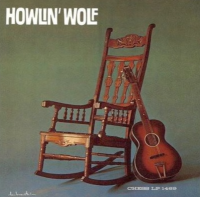 Chester Arthur Burnett, Howlin Wolf, was also a Chicago Bluesman and saw himself as Muddy Waters's rival. He wrote many songs which would become Blues and Rock-and Roll standards.
Chester Arthur Burnett, Howlin Wolf, was also a Chicago Bluesman and saw himself as Muddy Waters's rival. He wrote many songs which would become Blues and Rock-and Roll standards.
Born in Mississippi of African and Choctow descent \, Burnett started his career singing in church. He then hung out with Charley Patton who introduced him to the Mississippi Delta Blues which had picked up and sped up the sound of Jefferson's Texas Blues.
Bessie Smith
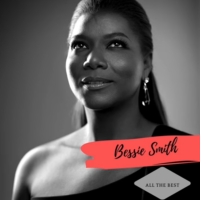 The jump blues out west and the country swing in the south draw from the same deep well of Bessie Smith.Smith did try a pivot to swing in 1937 but went back to Blues before here life got cut tragically cut short in two automobile accidents.
The jump blues out west and the country swing in the south draw from the same deep well of Bessie Smith.Smith did try a pivot to swing in 1937 but went back to Blues before here life got cut tragically cut short in two automobile accidents.
Jump Jazz/Blues
Lionel Hampton
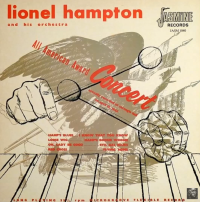 The other precursor to Rock and Roll was R&B, first called Race Music, which was influenced by jump blues, what many people today call swing music. Lionel Hampton, especially his 1942 hit Flying Home. The up-tempo had the signature backbeat that lives on in rock today.
The other precursor to Rock and Roll was R&B, first called Race Music, which was influenced by jump blues, what many people today call swing music. Lionel Hampton, especially his 1942 hit Flying Home. The up-tempo had the signature backbeat that lives on in rock today.
The jump jazz influence was real popular on the West Coast and you can hear much of the roots of Surf music.
Louis Jordan
 Jordan, known as the “King of the JukeBox” helped to invent jump jazz and bring Black music traditions of the South and make them front in center in Hollywood and out west.
Jordan, known as the “King of the JukeBox” helped to invent jump jazz and bring Black music traditions of the South and make them front in center in Hollywood and out west.
Jump Jive kept the 2/4 beat with the piano as the lead. Carl Hogan, the tympany guitar player though laid down riffs that would lead to the guitar replacing the piano as lead in R&B and Rock and Roll.
Big Joe Turner
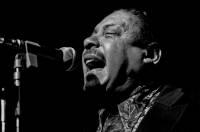 Another boogie woogie great Big Joe Turner was a “shouter” in jump jazz bands. His song “Shake, Rattle, and Roll” is probably the first rock and roll song to hit #1 on the charts.
Another boogie woogie great Big Joe Turner was a “shouter” in jump jazz bands. His song “Shake, Rattle, and Roll” is probably the first rock and roll song to hit #1 on the charts.
As a “shouter” Turner bridged the big band era while foreshadowing the lead singer in rock bands and the emcee in Hip Hop.
Turner also got his start at the Apollo Theater in Harlem, an important institution that shaped rock and roll (and so many other genres).
Meade Lux Lewis
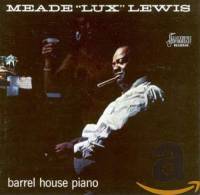 While Carl Hogan provided the guitar licks and Louis Jordan the vibe of rock and roll the boogey woogie piano players laid the foundation of the 2/4 beat.Meade Lux Lewis was one of the greatest boogey-woogie bashers of ivory.
While Carl Hogan provided the guitar licks and Louis Jordan the vibe of rock and roll the boogey woogie piano players laid the foundation of the 2/4 beat.Meade Lux Lewis was one of the greatest boogey-woogie bashers of ivory.
Boogey Woogey followed the same time scales of Blues but provided the upbeat rock and roll would need. Music meant for dancing and drinking. Not just drinking.
Boogey Woogey does usually follow a 12 bar meter. Rock n roll settled on an 8 bar as boogey woogey went from piano, dualing piano, and then lead guitar….thanks to Mr. Chuck Berry….
Boogey Woogey was so connected to the other elements like Western Swing, Texas/Chicago Blues, and Jump Jazz.Blind Lemon Jefferson called the bass lines supplied by guitar “Booga Rooga” (the word derves from some West African language brought with slaves).
Boogey Woogey, like much of the Blues, got created in Texas where people noted a “Fast Western” style among Black ragtime players.Fun fact…the “Western” in Country and Western..isn't a direction. “Freed” Slaves who built the railroads for Texas Western Railroad Company called that unique Texas ragtime “Fast Western” in reference to the railroad company.
This became the “Western” half of Country Western.
Country and Western
Emmet Miller (CW: Blackface)
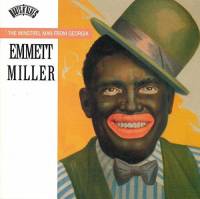 A minstrel, often performing in blackface, Miller influenced the country swing that would help shape rock and roll.
A minstrel, often performing in blackface, Miller influenced the country swing that would help shape rock and roll.
Many country and rock stars have covered his music. Hank Williams 1922 Lovesick Blues, Merl Haggard, and Van Halen.
Emmet Miller is probably the most important American musician you never heard of. His blackface and dedication to racist genre of minstrel shows is quite problematic.
I chose to include Emmit Miller in blackface because the minstrel era provided so much of direction for jazz, blues, and later rock and roll. It also marks the first widespread commercial appropriation of African Diaspora Art. A Racist homage to styles tracing back to the Western African Griot.
Minstrel shows lampooned Black and Slave culture. Miller represented the last gasp of minstrel shows in the 1920s. In 1949 he did a show called the “Last Great Minstrel Show”…People recognized the horrible caricatures but the appropriated minstrel music changed America.
Emmett Miller also influences all the Texas Blues and the Country swing that would go on to create rock and roll.
Bob Willis and the Texas Playboys
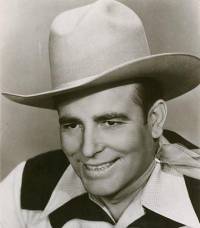 Bob Willis took the influence of Bessie Smith and Emmett Tiller and gave rise to the Country Swing that would mix with Texas/Chcago Blues and jump blues to become rock and roll.
Bob Willis took the influence of Bessie Smith and Emmett Tiller and gave rise to the Country Swing that would mix with Texas/Chcago Blues and jump blues to become rock and roll.
We can hear this evolution in his rendition of Ida Red.
Ida Red was an American folk song with no known origin. Willis recorded it in 1938 using the 2/4 Dance beat common in jazz and blues.
The same beat that traces its roots in slave fields and back to West Africa.
Willis also performed in Blackface, but saw it , incorrectly, more as a sign of respect than lampooning. Willis grew up picking cotton on his farm and noted until 7 or 8 he didn't know any white kids. He would dance jigs and play fiddle with the black workers and children on his farm.
When asked if he learned his stagecraft, with a ton of swagger and call and response (that you see in Hip Hop and all forms of rock)from vaudeville Willis replied no. It was listening and hanging out with Black musicians. Willis said his goal was always to play as good as his Black friends.
Rockabilly
After the boogie swing craze country artists such as Moon Mullican and the Delmore brothers began to record a swing sound they called “Hillbilly Boogie” Stories of hillbillies backed by a swing beat.
Million Dollar Quartet
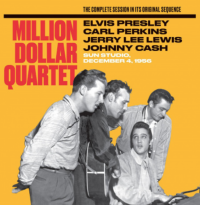 Rockabilly bridges Country swing, Gospel, and Rock and Roll. No album better illustrates the connection to Gospel than the “Million Dollar Quartert”
Rockabilly bridges Country swing, Gospel, and Rock and Roll. No album better illustrates the connection to Gospel than the “Million Dollar Quartert”
The album, an accidental recording when Elvis Presley, Carl Perkins, Jerry Lewis, and Johnny Cash hung out in a studio in Memphis, Tennessee.
Carl Perkins
The Perkins Brothers Band. consisting of the sons of sharecroppers grew in popularity, The audeinces wanted more of the Hillybilly songs with the jive sound. In 1955 they recorded “Blue Suede Shoes” which Elvis would make famous.
Elvis Presley
Elvis, “The King” Presley remains a cultural icon. His career began at Sun Records when Sam Phillips wanted to bring the black sound to wider audiences. Reportedly saying, “Over and over I remember Sam saying, 'If I could find a white man who had the Negro sound and the Negro feel, I could make a billion dollars.”
Presley coming from an unstable home life and seen as a loner in school would often bring his guitar and play hillbilly music at lunch. In 1954 Sam found his man.
Bill Haley
Bill Haley recorded the first rockabiliy album in 1951. In 1954 Bill Haley and the Comets recorded “Rock Around the Clock.” Used in a movie soundtrack the album shot to the top of the charts in 1954 and 1955, It remains one of the best selling songs of all time.
Gospel
Thomas Dorsey
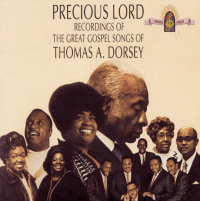 The final, and first, building block of Rock and Roll belongs to to the Black Church. Gospel music shaped America.
The final, and first, building block of Rock and Roll belongs to to the Black Church. Gospel music shaped America.
The AME has probably produced more Top 100 hits than the Julliard could in a 100 centuries. When the commercial recording industry took off Thomas A Dorsey drove Gospel to new levels.
In fact the so called “Father of Gospel” became so popular recorded gospel songs were called Dorsey's for awhile.
Precious Lord Recordings Of The Great Gospel Songs of Thomas Dorsey
Billy Wright
 An openly gay Black man in 1940-50s Atlanta Wright grew up singing Gospel in church. He became a main stay in the Atlanta, GA Blues scene.
An openly gay Black man in 1940-50s Atlanta Wright grew up singing Gospel in church. He became a main stay in the Atlanta, GA Blues scene.
The flamboyant performer was known as the “Prince of Blues” and gave Little Richard style lessons.
His first record, in 1949, reached #3 on the Billboard R&B category (called Race Records at the time)
Rock And Roll
Chuck Berry
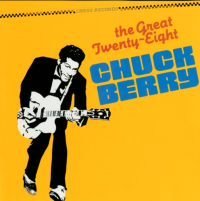 Chuck Berry gets the moniker of “father of Rock and roll”
Chuck Berry gets the moniker of “father of Rock and roll”
In 1955 Chuck Berry recorded Maybeline which riffed off of Bob Willi's “Ida Red.”
Berry took the lead from Charles Hogan and replaced the leading piano with a leading guitar. The same stop time and 4 beat bar that traces through blues and jazz.
Berry took the showmanship of T-Bone Walker and amplified the swagger. and wrote lyrics on themes of commercialism, fast cars, and youth that Post WWII America wanted.
Berry wanted to play blues so when he moved to Chicago Muddy Waters introduced Chuck to Leonard Chess of Chess records (the big Chicago Blues label)…When Leonard heard Berry's Maybeline version of Ida Red though Leonard recognized something special.
Rock and Roll, with its roots in the Jazz of New Orleans and the slave plantations of Texas was born.
Fats Domino
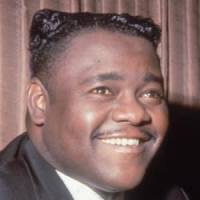 Fats Domino brought the back beat. A New Orleans bluesman his song “Fat Man” an adaption of a song about drug addicts called “Junker Blues”
Fats Domino brought the back beat. A New Orleans bluesman his song “Fat Man” an adaption of a song about drug addicts called “Junker Blues”
By 1951 it became the first rock and roll album to sell over a million copies.
Domino defined rock and roll as “It wasn't anything but the same rhythm and blues I'd been playin' down in New Orleans.”
Domino and his producer Dave Bartholomew added a second line beat found in pop today…The same second line syncopation you will find in any New Orleans drum line.
Domino's popularity, he has 37 top 100 hits, helped to usher in civil rights movements. Riots broke out four times at his integrated concerts…..Fats and his band often could not sleep in the same venue they played.
Bo Diddly
 The explicit connections between Rock and Roll and the African Diaspora come out more in the music of Bo Diddley than any other musician.
The explicit connections between Rock and Roll and the African Diaspora come out more in the music of Bo Diddley than any other musician.
Plus he rips on the axe.
Diddley “created” what became known at the Diddley Beat. He used African responses of call and responses and 3-2 clave rhythm that traces back to Afro-Cuban music and Yoruba drumming traditions in Ghana.
Diddley would play the “dozens” with together band members during live performance and write lyrics about love, crime and raw street life…Sound like hip hop?
Little Richard
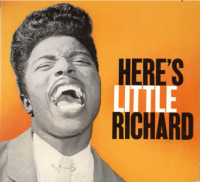 Little Richard, when inducted in the Apollo Hall of Fame, was labeled the “Architect of Rock and Roll.”
Little Richard, when inducted in the Apollo Hall of Fame, was labeled the “Architect of Rock and Roll.”
Like Wright, Richard Penniman grew up in Georgia gospel. Wright, provided fashion advice to Richard and even suggested Little Richard copy his hair cut.
The Flamboyant Richard would always struggle with his sexuality, and his identity of a performer and preacher of cloth.
Penniman would shape music forever, Tutti Fruti went #1 in 1956. He would get into fights with Elvis. Teach Paul McCartney to sing and drove his guitar player, Jimi Hendrix from the band in 1956.
Little Richard joins Fats Domino and Bo Diddly for integrating music and paving the way for both Rockabilly and other white Rock and Roll acts.
Jerry Lee Lewis
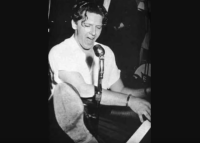 Following the Gospel/Country Swing into Rockabilly line was the only other person who could maybe come close to Little Richard on the piano. He took rockabilly beyond Perkins, Presley, and Haley and sung rock-and-roll.
Following the Gospel/Country Swing into Rockabilly line was the only other person who could maybe come close to Little Richard on the piano. He took rockabilly beyond Perkins, Presley, and Haley and sung rock-and-roll.
Jerry Lee Lewis crushed the keys. Great Balls of Fire stands on the Rock And Roll Song Pantheon.
Lewis faded in popularity quickly. Marrying your 13 year old cousin can do that.
Buddy Holly
Another rock and roll crossover from rockabilly Buddy Holly's death along with Ritchie Valens and Jiles “Big Bopper” Richardson marks the end of rock-and-roll as an era.
Rock Music
Not just in Mclean's 1971 song “The Day the Music Died” but also to the dominance of the 2/4 beat. A new genre of rock would soon emerge. In the States, Little Richards former guitar player, Jimmy Hendrix, would reinvent the guitar.
Across the Atlantic bands such as the Beatles,influenced by Elvis, and the Rolling Stones, drawing on American Blues, would emerge. Along with the British Invasion came the “mercerbeat.” This four count beat is heavily influenced by the 12 bar blues and the 4 count of rock and roll but the emphasis is often on all four beats unlike the 2-4 beats and second lines of blues and Rock-and-Roll.
Music of the African Diaspora
Black music of the African Diaspora would continue to evolve. We would see a rise of Motown in Detroit which connected more with Jazz than the Blues. This would lead to the emergence of Rhythm & Blues and Soul.
Chuck Berry's bass players, Bootsy Collins, and a few others would break from the four count mercerbeat and put the emphasis on the first beat called funk.
After a second round of appropriation, similar to rock emerging from rock-an-roll, Disco would emerge from funk. Meanwhile as rock grew statesside Deejays in Jamaica would strap huge speaker systems to the back of pick up trucks and drive around the country side riffing off of lyrics leading to the emergence of reggae.
The influence of funk, reggae and the Jamaican Sound System would emerge as Hip Hop when an entrepreneurial young woman convinced her brother to spin a few records at a house party in the Bronx.
